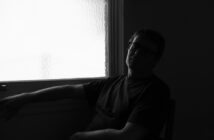Melbourne artist Tim Catlin formed the Overtone Ensemble in 2012 in order to perform works using his self-made “Vibrissa” instruments. Each instrument consists of twelve vertically mounted aluminium rods that are longitudinally stroked by hand to produce ethereal “singing” tones. The long sustaining nature of the rods sound and microtonal tunings allow players a sonic palette of complex textures and harmonic complexity. Other instruments used include massed hand-bells, quarter-tone bells, e-bowed acoustic guitars, re-tuned glockenspiels, wineglasses and long wire instruments. The Overtone Ensemble are Tim Catlin, Atticus Bastow, Philip Brophy and David Brown. The debut Overtone Ensemble album is due June 30th via Important Records.
We’ve been fans of Catlin’s work for a while now, we interviewed him in 2008 when he was experimenting with electronic bug sounds created via guitar, and have enjoyed his solo albums such as the stately Radio Ghosts, as well as his two collaborations, Glisten (2010), and Whorls (2015) with Dutch experimental musician Machinefabriek. Whether it’s with guitar, electric sitar, or the vibrissa, Catlin’s music is always fascinating and unique, not unlike his musical taste. With the impending release of the Overtone Ensemble’s debut, we asked him to compile some of his favourite music for us.
Ellen Fullman – “Bass Song”(Body Music, XI Records)
Fullman’s long string instrument comprises 80 string sets of 25 metre plus strings attached to wall mounted resonators. The instrument is huge and sounded by players spaced out along the length of the strings. Performers walk around the strings stroking and striking them with rosined hands. The instruments design allows complex sets of overtones and harmonies from deep bass to high partials of the harmonic series. It sounds as though you are listening inside the innards of some huge harmonica or organ.. Other composers have worked with long string instruments (Paul Panhuysen and Alastair Galbraith to name two), but no one has taken it as far or developed it as she has – a true innovator and a huge inspiration as an instrument designer.
Harmonia – Musik Von Harmonia (Brain)
It’s impossible to single out just one Krautrock track really as I’m a big fan. This whole album is perfect though. From it’s floating cosmic sunrises to pulsing motorik shimmer it is an immaculate production. The inner foldout photo of the groups country studio, full of guitars and electronics was a romantic inspiration for me of what a studio could look like, and it hinted at music making possibilities beyond the rock canon.
Reichel built and played his own unique guitars. They are picked behind the bridge (not in front like regular guitars) and their sound is based on resonance and harmonic relationships between the regular strings and those behind the bridge. His playing is virtuosic, experimental, often humorous, and totally sui generis. I heard Reichel for the first time through a Guitar Player magazine flexi-disc and was flummoxed. I had no idea how he was making these bizarre and beautiful sounds. Recently I’ve had a guitar modified to a “behind the bridge” Reichel style guitar, so I’m still trying to work it out!
Ennio Morricone – “Svolta Definitiva” (Citta Violenta, GDM Music)
Italian action, horror and exploitation films from the 70s provided a huge goldmine of amazing music from people like Nico Fidenco, Piero Piccioni, Bruno Nicolai, Goblin and of course, Ennio Morricone. Working across all sorts of styles this music ranges through cheesy, funky, garish, strident, avant garde and classical pastiche – all often within the same soundtrack! It’s fun, catchy, throwaway and deep music. I love it. Svolta Definitiva from Citta Violenta (Violent City) is a good example with its driving rhythm, fuzz guitar frenzy and relentless organ workout.
Brian Eno – “The Great Pretender” (Taking Tiger Mountain by Strategy, Island)
Perverse imagery, oddly treated guitars and an extended coda of chirruping insect synths. This track exemplifies some of Eno’s production tactics from the time: studio as instrument, repetition as a form of change and randomized lyric production.
Eno’s 70’s pop albums were a big obsession of mine not just for the music (ambient lullabies, proto-punk, minimalist pop etc), but their ideas and references led me to other interesting artists and lines of enquiry. (Steve Reich, Robert Fripp, William Burroughs, cut-ups, automatism and Eno’s Oblique Strategies just to name a few.) From his days on the first two Roxy Music up to his work with Cluster in the mid 80’s it seemed that everything he did turned to gold. It was later when Eno started working with people like U2 and Coldplay that I realised he was indeed fallible.
Toshio Hosokawa – “Banchikicho no Choshi” (Deep Silence, Wergo)
The album mixes Hosokawa’s take on traditional Gagaku court music and his original compositions. He fuses the sounds of European accordion and traditional Japanese mouth organ, the Sho in such a way that it’s hard to tell which is which. Hosokawa has called music “a place where notes and silence meet.” and Deep Silence refers to the Japanese concept of “Ma” in this way. Literally meaning space or interstice, in a musical sense it refers to the space between sounds or the period of waiting before a note is sounded. The breathing in Zen meditation with its very slow inhalation and exhalation also forms a rhythmic basis for the slow motion dynamics of these pieces. They all unfold at a glacial pace and their fragile beauty seems to suggest limitless space and nothingness.
Meredith Monk – “Unison” (Our Lady of Late, Wergo)
“Unison” comprises solo vocal performance with a rubbed wine glass accompaniment. The track begins with both voice and wineglass tones in unison. As it proceeds, Monk gradually changes pitch in small microtonal shifts, causing beating or interference patterns between her shifting, morphing vocalisations and the constant pitch of the glass. It’s a simple and brilliant exploration of beating phenomena and minimalist exposition. This was my introduction to extended vocal technique and to Meredith Monk. “Dolmen Music” is another favourite of mine, although by that stage she was using multiple voices and piano in her pieces. In many ways I feel “Our Lady of Late” is her bravest and purest work for its stark simplicity and conceptual rigour.
Sonic Youth – “I Love Her all the Time” (Bad Moon Rising, SST)
I saw them a number of times between 83 and 84 in New York and quickly became a fan. These days the dissonance and dirt of their early music reminds me of what the city looked and felt like back then – ragged and slightly out of control.
This track has a haunted, dream-like quality that I love from this period of their music. The juxtapositions of harmonics/noise, close/out tunings, and consonance/dissonance are all tropes that they would refine over later albums, but Bad Moon Rising and EVOL remain my favourites.
Other guitar drone/alternate-tuning contenders: Glenn Branca, Savage Republic, Rhys Chatham and Mike Leander.
Francisco Lopez – “La Selva” (V2)
Lopez’ field recordings were all captured in the rainforest in Costa Rica during a day cycle in the rainy season. There’s a wide range of sounds including rain, waterfalls, insects, frogs, birds, mammals and plants, however this is not a new age relaxation session or bucolic soundscape. The chaos, rhythmic diversity and aural density of the forest are not relaxing – many insect noises sound like harsh electronic frequencies and rainstorms and waterfalls are closer to broadband noise. It’s a recording that rewards deep listening and each time I put it on I hear something new. Lopez describes La Selva as “..not an easy background sound; it’s a tour de force of transcendental listening that can lead to many places.” In this age of constant hyperbole and self-aggrandisement I’d love to disagree with his assessment, but no, he is spot on.
Scientist –“Beaming” (Dub Landing, Starlight)
My earliest introduction to dub music was a cassette mix tape of Scientist albums. It’s still playable and I still enjoy listening to it. A lot of his 80’s albums are theme based, like Scientist Rids the World of the Evil Curse of the Vampires, Meets the Space Invaders, Wins the World Cup, Heavyweight Dub champion etc. Most have outlandish cartoon style covers that make you want to hear what they actually sound like. He may not be as notorious as Lee Perry or as heralded as King Tubby, but I’d put him in the same class. This version turns up the bass and vaporizes the vocals. To hear what’s been dubbed and effected, here’s the original track by Freddie McKay.




